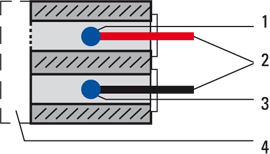The head of the VQ sensor functions on the principle of heat reaction. When combustible or reducing gases or vapours come in contact with the measuring element, they are subjected to catalytic combustion, which causes a rise in temperature.
This rise causes a change in the resistance of the measuring element which is used as a measure of the component of gas being tested. The inert element is for compensating the temperature and conduc tivity of the test gas.

1 = Catalyzer pellistor
2 = Electric connections
3 = Inert pellistor
4 = Diffusion filter